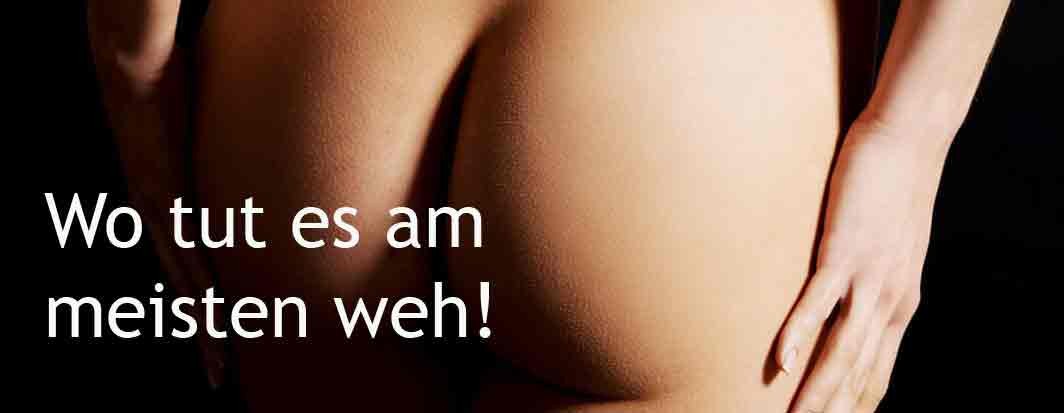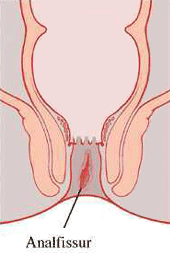Definition
What is an anal fissure?
An anal fissure is a small tear of the skin of the anus. Although the tear is small, it can be very painful because the anus is very sensitive. The pain tends to be worse when you pass faeces (sometimes called stools or motions) and for an hour or so after passing faeces. Often an anal fissure will bleed a little. You may notice blood after you pass faeces. The blood is usually bright red, stains the toilet tissue, but soon stops.
Anal fissures are common in both adults and children. They are not usually serious, but they are sore and can be distressing, particularly for children.
What causes an anal fissure?
Common causes:
Most anal fissures are thought to be due to passing large or hard faeces when you are constipated. The rim of the anus may stretch and tear slightly. Spasm (tightening) of the muscle around the anus (the sphincter) may play a part in causing the tear, or in slowing down the healing process. (If the muscle around the anus is tight, the blood supply to the anus is reduced. This may affect how well the tear heals.)
In about 1 in 10 cases, the fissure occurs during childbirth. Sometimes an anal fissure occurs if you have bad diarrhoea.
Anal fissures and other conditions
In a minority of cases, a fissure occurs as part of another condition. For example, as a complication of Crohn’s disease or an anal herpes infection. In these cases you will have other symptoms and problems as well. These type of fissures are not dealt with further in this leaflet.
What is the treatment for an anal fissure?
In most cases the fissure will heal within a week or so, just like any other small cut or tear to the skin. Treatment aims to ease the pain and keep the faeces soft whilst the fissure heals.
Easing pain and Discomfort
• Warm baths are soothing, and may help the anus to relax which may ease the pain.
• A cream or ointment that contains an anaesthetic may help to ease the pain. You should use this only for short periods at a time (5-7 days). If you use it for longer, the anaesthetic may irritate or sensitise the skin around the anus. You can get one on prescription. You can also buy some of these products at pharmacies without a prescription.
• A cream or ointment that contains a steroid may be prescribed by a doctor if there is a lot of inflammation around the fissure. Steroids reduce inflammation, and may help to reduce any swelling around a fissure. This may help to any ease itch and pain. You should not use it for longer than one week at a time.
• Wash the anus carefully with water after you go to the toilet. Dry gently. Don’t use soap whilst it is sore as it may irritate.
• Painkillers such as paracetamol may help to ease the pain (but avoid codeine – see below).
AVOIDING CONSTIPATION AND KEEPING FAECES SOFT
• Eat plenty of fibre by eating plenty of fruit, vegetables, cereals, wholemeal bread, etc.
• Have lots to drink. Adults should aim to drink at least two litres (10-12 cups) of fluid per day. You will pass much of the fluid as urine, but some is passed out in the gut and softens the faeces. Most sorts of drink will do, but alcoholic drinks can be dehydrating and may not be so good.
• Fibre supplements. If a high fibre diet is not helping, you can take bran, or other fibre supplements (‘bulking agents’) such as ispaghula, methylcellulose, or sterculia. You can buy these at pharmacies or get them on prescription. Methylcellulose also helps to soften faeces directly which makes them easier to pass.
• Toileting. Don’t ignore the feeling of needing the toilet to pass faeces. Some people suppress this feeling and put off going to the toilet until later. This may result in bigger and harder faeces forming that are more difficult to pass later.
• Avoid painkillers that contain codeine such as co-codamol, as they are a common cause of constipation. Paracetamol is preferable to ease the discomfort of a fissure.
What are the treatments for chronic (non-healing) anal fissure?
Anal fissure treatment
Overview
Overview
Treatment aims to ease the pain and keep the faeces soft whilst the fissure heals.
What are the treatments for chronic (non-healing) anal fissure?
If you left a chronic anal fissure, there is a reasonable chance that it will heal on it’s own without any treatment, or just with warm baths and pain relief. However, some persist and treatment helps to heal the fissure as quickly as possible.
Treatment of a chronic anal fissure aims to:
• relax the muscle tone of the muscle around the anus. This allows a good blood flow and enables the fissure to heal as quickly as possible.
• keep the faeces soft and easy to pass.
Most acute anal fissures can heal with home treatment in 4 to 6 weeks. Pain during bowel movements usually goes away within a couple of days of treatment. A fissure that has not healed after 6 weeks is considered long-term, or chronic, and will need additional treatment.
Medication and fibres are usually the first-line treatment for chronic fissures.
Glyceryl trinitrate or Calcium channel antagonists ointment
Anal Cone helps relax the anal sphincterIf you apply glyceryl trinitrate (GTN) or Calcium channel antagonists ointment to the perianal area, it relaxes the muscle around the anus (the anal sphincter). This allows the fissure to heal better. It may also ease the pain very quickly. Once the sphincter muscle is relaxed it should be gently dilated with a special cone as shown in the right image
About 7 in 10 people with a chronic anal fissure are cured with a course of GTN ointment. (About 5 in 10 will heal in this time with the ‘traditional’ treatment of regular warm baths and using an anaesthetic cream for pain relief.) Therefore, the chance of cure by using GTN is better than the traditional method.
Some points to note if you use GTN ointment include the following.
• There is only one branded product of GTN ointment that is used to treat anal fissue. It is called Rectogesic and is only available on prescription. Rectogesic contains 0.4% GTN. You should use this exactly as described on the leaflet that comes with the packet. For example:
• A standard dose is 2.5 cm squeezed out of the tube. (A measuring line comes with the product to measure 2.5 cm of ointment.)
• You squeeze a dose of ointment onto a finger (which you can cover beforehand with cling film or similar). You then place the ointment just inside the anus.
• The ointment is used every 12 hours until pain goes, or for up to 8 weeks maximum. (Some doctors advise to continue with the ointment for a full 6-8 weeks even if the pain goes much sooner. This is because it often takes 6-8 weeks of treatment for the fissure to heal fully, even if the pain has gone.)
• The product leaflet gives details of who should not use the ointment and what side-effects that may occur.
• Up to 6 in 10 people have a headache after applying GTN ointment. (The GTN gets into the bloodstream and may cause a headache.) The headache usually goes within 30 minutes. Painkillers such as paracetamol will help if a headache occurs. If headaches are troublesome, try using a smaller amount of ointment for a few days, and then gradually increase the amount back to normal over several days.
• Another tip if you get bad headaches is to rub a smaller amount of ointment (a pea sized amount) around the rim of your anus rather than inserting the full amount into the anus. GTN is absorbed more into the bloodstream from the thin skin inside the anus. Using a smaller dose of ointment just on the rim of the anus may avoid side-effects (but may not be as effective as using the full dose inserted into the anus.)
• For people aged 12-18, and for people who develop bad side-effects such as headache, your doctor may advise a lower strength of GTN ointment. There is no commercially available ointment that is a lower than 0.4% strength. However, a pharmacist can make up a 0.2% strength of ointment by diluting a stronger 2% preparation which is used for other medical conditions.
• The calcium channel blockers nifedipine and diltiazem also may help healing, also by reducing the pressure in the internal anal sphincter. These two medicines are available as tablets.
• Botulinum toxin (Botox) may be injected into the internal anal sphincter. Botox causes temporary paralysis of muscle, which can reduce muscle tension and help the anal fissure heal.
Surgery
Surgery is an option if GTN treatment does not work. It is also an option if you have recurring fissures. The success rate with surgery is very high – at least 9 in 10 cases are cured. The usual operation is to make a small cut in the muscle around the anus (‘internal sphincterotomy’). This permanently reduces the tone (pressure) around the anus and allows the fissure to heal. This is a minor operation which is usually done as a day-case under general anaesthetic.
Chronic anal fissure in ano have often sentinel tags or piles, as they were known, that cause imilar symptoms that were associated with hypertrophied papillae or fibrous anal polyps.Hypertrophied anal papillae and fibrous anal polyps are important anal pathologies associated with chronic anal fissure and are responsible for symptoms like pruritus, a pricking sensation, heaviness, etc.
Their removal should be made an essential part of treatment of chronic fissures in ano. Persistence of these structures leaves behind a sense of incomplete treatment and thereby reducing the overall satisfaction on the part of the patient. Laser-assistend procedures have been found useful in successfully eradicating these concomitant pathologies of chronic anal fissure. This procedure should be given a fair chance to prove its utility and long-term efficacy.
If you have had one anal fissure, after it has healed you have a higher than average chance of having another one at some time in the future. The best way to avoid a further fissure is to avoid constipationby using the measures described above. That is, a high fibre diet, fluid, etc.
Leaflets that list foods high in fibre are commonly available.


